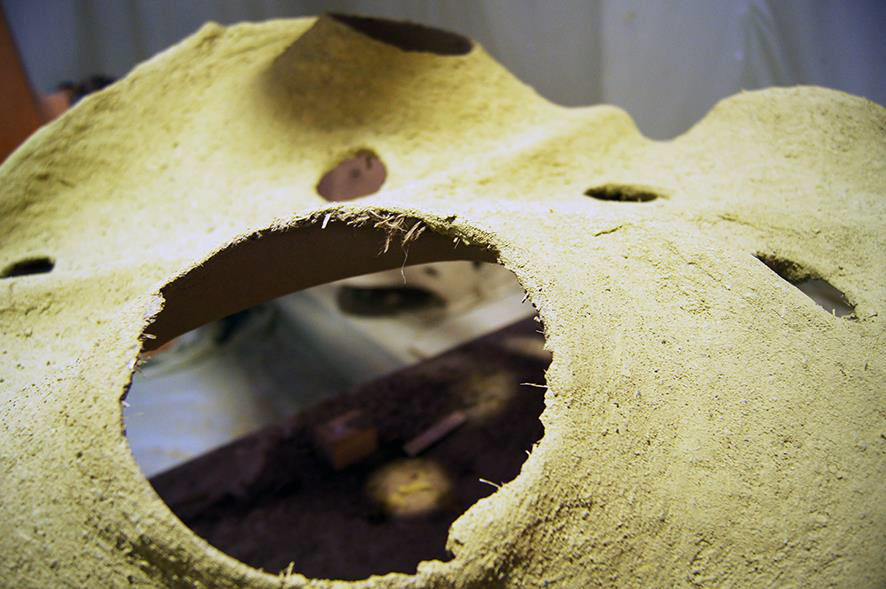Earth, Wind, Rough Skins and Piercings
CFD and Karamba analysis on earthen shells working on the perforations and 3d textures on the outer and inner skins of the shells and seeking passive ventilation performance through simulations and extended physical prototyping.
Preliminary workshop
Faculty: Stephanie Chaltiel, Angelos Chronis, Manja Van De Worp
Iaac Valldaura – Green Fab Lab 2017
6th and 7th February 2017
10am to 4.30pm
- 1st phase (Feb 2017): cfd and Karamba analysis on a large series of small perforated and 3d textured mud shells built by hand. Highlight of series of rules, actions and trajectories for future small robotic fabrication steps.
- 2nd phase(May 2017): Perforations, rough skins and fluid analysis on robotically and manually fabricated earthen shells.
Keywords: on site analysis and on site fabrication, fluids analysis, feedback loops between material fabrication and cfd simulations, 3d texturing, perforations, passive ventilation, wind flow.
 Fig1- perforated earthen Shells- robotically sprayed. group 2 during Iaac Digital Fabrication seminar- May 2016. Photo S. Chaltiel
Fig1- perforated earthen Shells- robotically sprayed. group 2 during Iaac Digital Fabrication seminar- May 2016. Photo S. Chaltiel
Syllabus
This Iaac Optional 2 days’ seminar proposes to the participants to build up on knowledge gained from Phriends* for Shells Iaac seminar 2016 on robotic fabrication for mud shells.
You can see the results here:
www.iaacblog.com/life/maa-advanced-robotic-fabrication-seminar/
www.iaacblog.com/life/iaac-at-smartgeometry-workshop-2016-hybrid-domains/
Earthen Shells perforations & Natural ventilation performance
We will be exploring the Morphology of the openings and defining regions on the shells to analyse and fabricate those micro morphologies with deep influence on the wind flow. See Fig1.
We will be running a series of cfd analysis to understand where it is better to have the openings, defining regions of the shell.
We will then vary they density and simulate its effect on the wind flow. We build a large series of small perforated shells of 20 cm side varying a parameter at the time.
Our main goal here is to investigate the relationship between the shell’s main nerves and feet with the perforations type & density. We will also simulate and fabricate by hand thickness shell variation in the perforations regions and analyse its effect on passive ventilation.
Earthen Shells inner and outer skin’s roughness
Enjoyable manual craft will be creatively put in place to find new forms of inner and outer membrane roughness and textures constantly recalibrated by cfd analysis.
The outer and inner skin texturing can be interactive. See Fig2
 Fig2- Mud shells with textures. Svenja Keune’s work at Smart geometry cluster’ mud, fabrics and robots for large structures’ led by s. Chaltiel and A.Dubor- April 2016. Photo S. Chaltiel
Fig2- Mud shells with textures. Svenja Keune’s work at Smart geometry cluster’ mud, fabrics and robots for large structures’ led by s. Chaltiel and A.Dubor- April 2016. Photo S. Chaltiel
We will be looking through the simulations at passive ventilation performance but as well wind flow surprises thanks to the unusual geometries and textures fabricated. We will be doing a very large quantity of small earthen shells varying their geometry + 3d texturing and proportion to their bounding box[2], their inner and outer skin textures, and their perforations.
[1] Earth mix: mix of clay, sand fibres, water and air
[2] All mud shells will be place in a glass or polycarbonate box. Simulations will be run on the mud shell in their bounding box. (real architectural project will be one or various mud shells inside a greenhouse type simple structure)
Link to project videos: